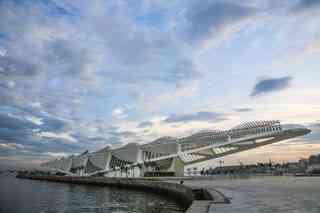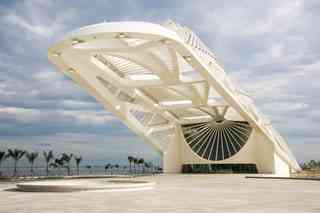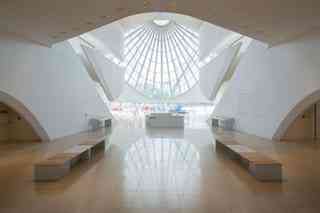July 28,2022
Santiago Calatrava’s Museum of Tomorrow Opens in Rio de Janeiro
by David Stewart

The Santiago Calatrava–designed Museum of Tomorrow has opened in Rio de Janeiro. The Spanish architect, engineer, and artist designed the waterfront science museum using organic shapes inspired by the bromeliads in the city’s botanical garden. “The idea is for the building to be as ethereal as possible, almost floating above the sea like a boat, bird, or plant,” Calatrava said in a release. He recorded his creative process in more than 600 watercolors.
“As the world becomes more and more urban, one of mankind’s greatest challenges ishow we occupy cities,” Eduardo Paes, the mayor of Rio de Janeiro, said in a release.“The Museum of Tomorrow is a symbol of the redevelopment of the important Port of Rio and, since its construction, has inspired reflection on our hopes for the city to be more integrated and more generous with public spaces.”

Situated in Praça Mauá, the 15,000-square-meter building sits on a 34,600-square-meter plot with reflecting pools, green spaces, a bike path, and a recreational use area. “The plaza creates a more cohesive urban space and reflects the neighborhood’s greater transformation,” Calatrava said.

The museum’s sustainable features include using water from the bay to regulate the temperature inside the building and to supply the reflecting pools outside. The building also sports photovoltaic solar panels, which provide the museum with solar energy.
The museum, located in the city’s growing Porto Maravilha neighborhood, explores six major trends expected over the next 50 years: climate changes, changes in biodiversity, growing population and increased life span, greater cultural integration and differentiation, advances in technology, and expanded knowledge.
The museum has partnerships with several of the most prominent science institutions in Brazil and abroad, including the National Institute of Space Research, the United Nations Educational, Scientific and Cultural Organization (UNESCO), and the Massachusetts Institute of Technology, among others.
The airy, sweeping structure includes more than 5,000 square meters of temporary and permanent exhibition space. It also has a 400-seat auditorium, shop, café, and restaurant.
“The building was built to be a museum for the future and an educational unit," Calatrava said. The museum is also part of a revitalization effort to make Rio’s port neighborhood, Porto Maravilha, one of the most attractive in the city.






